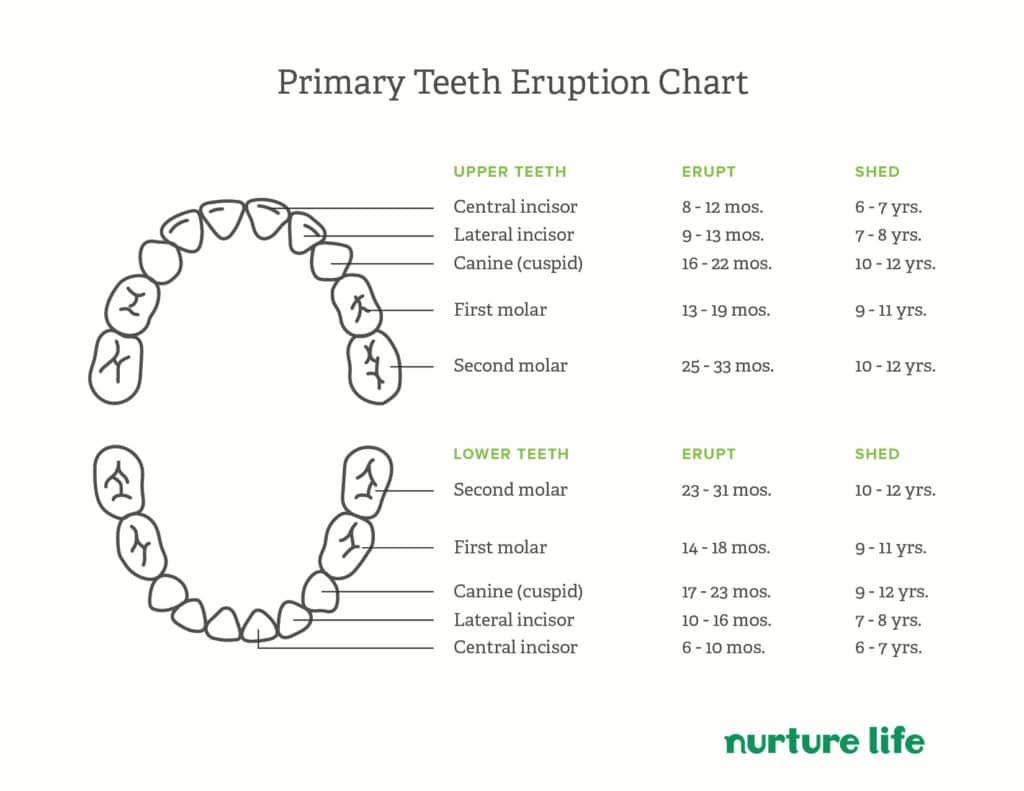6 Year Molars & Losing Baby Teeth: What to Expect
6 Year Molars and the Phases of Teeth Growth
After experiencing baby teething and the eruption of the 2-year molars with your little one, you may think that your child’s teething journey is complete—but they still have several phases to complete! All of your child’s baby teeth will be replaced by adult teeth between the ages of 6 and 12, and there are still additional sets of new, permanent teeth that will erupt: the 6 year molars, 12 year molars and wisdom teeth.

When Do Children Lose Baby Teeth
Between the ages of 6 and 12, your child will lose all 20 of their baby teeth. If their baby teeth erupted prior to 6 or 7 months, your child will likely start to lose these teeth early too, closer to 5 years old. Genetics play a large role in determining when your child’s baby teeth fall out and their adult teeth come in. Typically, kids lose their top 4 teeth and bottom 4 teeth between ages 6 and 8. The remaining 12 teeth, which are canines and molars, are lost between ages 10 and 12.
Some kids think losing teeth is exciting, while others find it uncomfortable and strange. If your child seems bothered, try explaining that losing teeth and growing new ones is a normal part of growing up.
What Teeth Come in at 6 Years Old
6-year molars erupt behind their 2-year molars. The 6-year molars represent new growth, meaning they don’t replace any baby teeth.
When your child’s 6 year molars erupt, symptoms can include headaches, cheek biting and ear or jaw pain, all of which typically last a few days. Fevers aren’t a common symptom of 6-year molars, but low-grade fevers and swelling can occur. Anterior teeth usually erupt with fewer symptoms than adult molars. If your child is experiencing soreness, have them gently massage their gums with a soft toothbrush or eat cold foods. When the teeth erupt, warm salt water rinses can help combat inflammation. Ibuprofen can help ease painful symptoms, but most kids won’t need it.
What to Eat During Molar Eruption
During this time, your child’s eating habits may change. You might notice a difference in their appetite or that they prefer softer foods. Try to be mindful of their overall diet to avoid imbalance. You can also make slight modifications to accommodate any pain. Cut up an apple instead of having them eat it whole, for example, or try dividing a sandwich into several sections to reduce the amount of chewing involved. Here are a few ideas for softer snacks and meals for your child if they experience aching or tenderness in their mouth.
Smoothies. Turn breakfast into a treat with this soft, cold smoothies. They’re quick to make if you have frozen food on hand and can be a healthy snack or breakfast option for your kid. You can even include dark green veggies like kale and spinach for an extra boost of vitamin K, which plays an essential role in healthy blood clotting.
Healthy popsicles. Make a quick-prep dessert for your kid that can also combat swollen gums. Try these creamy and fruity papaya popsicles or these kiwi coconut chia popsicles. You can also freeze your favorite smoothie combination into popsicles to enjoy later. Short on time to make your own popsicles? Scoop Nurture Life’s baby purees into silicone molds for tasty and healthy homemade popsicles without having to blend the fruits or veggies yourself.
Chilled applesauce. Put this standby snack in the refrigerator before serving to your kid for a cool, sweet dessert.
Soups and chilis. Healthy, vegetable-filled soups and chilis can be soft, nutritious, easy-to-eat options for your child. Try a white bean chili or a hearty vegetable stew to maximize on vegetables, and for a meat option, opt for chicken in your chili. Choose smoother soups, like this 2-ingredient butternut squash soup, if your kid’s teeth are very loose or their gums are very sore.
Mashed or soft veggies. Think mashed sweet potatoes, lightly cooked vegetables or spaghetti squash—options that aren’t too hard on the mouth but still nutritionally dense. Nurture Life’s balanced jars of finger foods offer the perfect texture and size of veggies for tender mouths!
Healthy tuna, chicken or egg salad. Skip the mayo and substitute unflavored Greek yogurt or avocado to make healthier versions of these classic salads.
Nurture Life Meal Recommendations
If you order Nurture Life’s meal delivery for your little ones, we’ve also got plenty of options that are tender, soft and easy to eat for kids with erupting molars. The exact offerings on our kids meal menu vary each week, but here are a few recommended options to look out for:
- Mac & Cheese with Cauliflower: Veggies don’t get much softer than when they’re smoothly pureed like the cauliflower in our Mac & Cheese with Cauliflower. The soft whole wheat macaroni and creamy cheese sauce are easy on sore teeth while being mindful of a well-balanced diet for your little one.
- Cheesy Zucchini Pomodoro: Whole wheat shells, housemade pomodoro sauce and a three-cheese blend make a comforting base for roasted zucchini, a soft and easy-to-chew veggie that still packs in nutrients!
- Frittata with Cinnamon French Toast: Our mini frittata cups are packed with finely chopped veggies and cheddar cheese for an easy-on-the-teeth breakfast dish that can be enjoyed any time of day. We serve it with soft little slices of french toast bread pudding made from whole wheat bread and a light custard sprinkled with cinnamon.
How can I help ease my child’s discomfort during molar eruption?
You can encourage your child to gently massage their gums with a soft toothbrush, provide cold foods like smoothies or chilled applesauce, or use warm saltwater rinses. Ibuprofen can be considered for significant discomfort, but consult with your pediatrician first.
Is it normal for my child to lose appetite during molar eruption?
Yes, children may have a reduced appetite or prefer softer foods while their molars are erupting. Providing easy-to-chew and softer foods can help ensure they continue to eat nutritiously.
Are fevers normal during teething?
Low-grade fevers can sometimes occur during teething, but high fevers (above 104°F) are not typical and should be evaluated by a pediatrician immediately.
When should I see a pediatrician or dentist?
During this stage, routine dental checkups give kids an opportunity to learn about healthy eating habits while also making sure their teeth are cavity-free. As their adult teeth begin to erupt, you’ll see how your child’s bite is developing and whether early orthodontics might be needed. X-rays can help track growth and development as well as assess surfaces in between teeth. Work with your child to take care of their teeth at home, especially as their adult teeth come in.
The American Academy of Pediatrics recommends a call to the doctor or an emergency room visit if your child has a fever above 104 °F. Take behavior and activity level into account, too. Observe how your child behaves and whether they’re acting like themselves.
Losing baby teeth can be a bonding experience for you and your growing child. It’s also a great time to practice communication skills with your kid, as they may find losing their teeth disconcerting or can experience aches as their 6-year molars erupt. Encourage verbal communication, and do what you can to accommodate them by providing softer and cooler foods. Most importantly, continue to encourage healthy teeth cleaning practices so that your child maintains healthy and strong adult teeth.
For more information about Dr. Reena’s work at Growing Smiles, please visit the Growing Smiles website.


